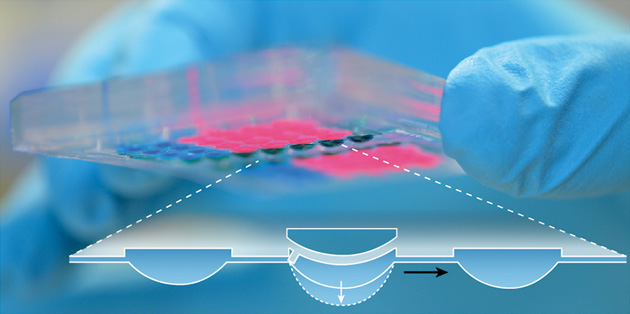Programmable V-type Valve for Cell and Particle Manipulation in Microfluidic Devices
Author Archive
New YouTube Videos
New YouTube Videos
Microscopic pumps made from trapped bacteria
Scientists in China have trapped bacteria in 3D-printed structures and used them to pump materials along customised paths.
Transporting materials in the microscopic world is complex. Conventionally, macroscopic pumps drive motion, but pumps are bulky and not ideal for miniaturisation. Now, Hepeng Zhang and colleagues at Shanghai Jiao Tong University have tackled this problem using native inhabitants of the microscopic world – motile bacteria. Not only are they already present in the media, but their energy conversion efficiency is estimated to be greater than existing man-made micro-motors.
Please visit Chemistry World to read the full article.
Using confined bacteria as building blocks to generate fluid flow
Zhiyong Gao, He Li, Xiao Chen and H. P. Zhang
Lab Chip, 2015, Advance Article
DOI: 10.1039/C5LC01093D
New YouTube Videos
Microfluidic device lets the drop beat
Scientists in Switzerland have incorporated pulsing human heart tissue into a microfluidic device to make a miniscule model of a living system that could be used to test new drugs.

The hanging drops are connected through 200μm-wide channels
‘This is one of the most interesting recent developments in the field of microfluidic systems,’ comments Wouter van der Wijngaart, who heads up the research into micro- and nanofluidic systems at the KTH Royal Institute of Technology in Sweden. ‘This type of system has the potential to become the de facto workhorse in the field of 3D microtissue culturing.’
Please visit Chemistry World to read the full article.
Adding the ‘heart’ to hanging drop networks for microphysiological multi-tissue experiments*
Saeed Rismani Yazdi, Amir Shadmani, Sebastian C. Bürgel, Patrick M. Misun, Andreas Hierlemann and Olivier Frey
Lab Chip, 2015, Advance Article
DOI: 10.1039/C5LC01000D
*Access is free through a registered RSC account until 19 November 2015 – click here to register
New YouTube Videos!
New YouTube Videos
Top 10 most accessed Lab on a Chip articles in June 2015
In June 2015, our most downloaded Lab on a Chip articles were:
Interesting read? Let us know your thoughts below.
And remember, you can submit directly to Lab on a Chip!










